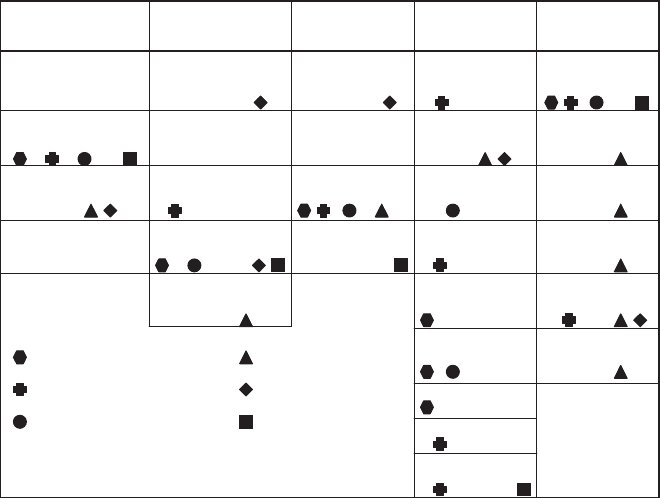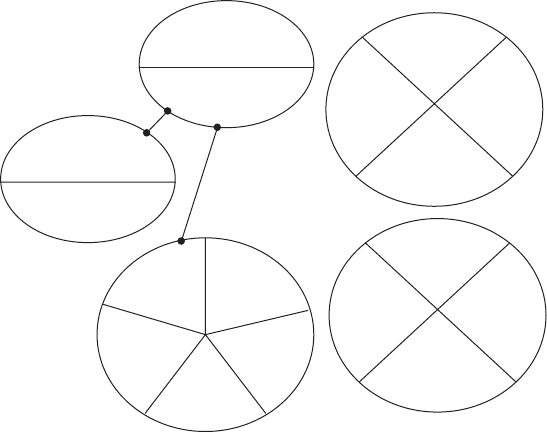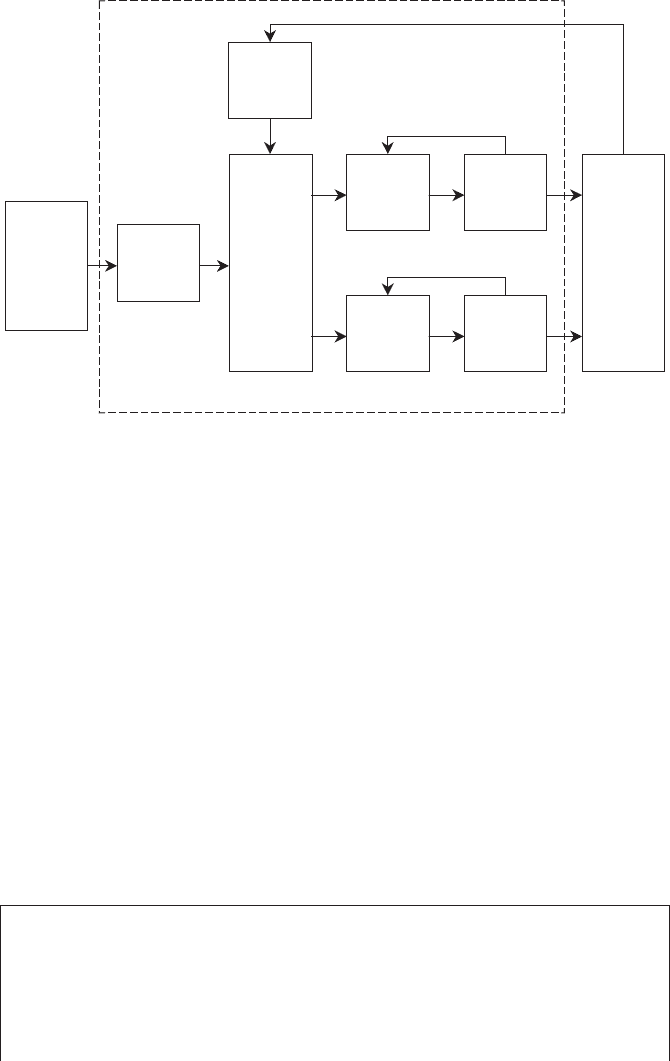Buede D.M. The Engineering Design of Systems Models and Methods
Подождите немного. Документ загружается.


least one column in the morphological box for each generic component in the
physical architecture. There are certainly situations in which one of the generic
components may have two or more columns associated with the generic
component; these would be the decomposed generic components of the higher
level component.
Second, there is no requirement that each generic component have the same
number of options. Clearly, there is value to having at least two choices for any
generic component; otherwise that particular generic component has been
fixed. Using some of the brainstorming or brainwriting techniques to be
discussed in Section 8.4.2 is common to develop additional alternatives (boxes)
for each generic component (column of the morphological box). There is great
advantage to generating a creative set of choices for any generic component,
even if some of the choices are never selected in the fina l set of alternate
instantiated physical architectures.
In addition, there are situations in which it is wise to permit more than one
choice from a generic component to be selected for a single instantiated
physical architecture. This possibility of selecting several choices in a single
generic component for a single instantiated physical architecture usually does
not make sense for a centra l component in the architecture . However, there are
often generic components associated with the ‘‘bells and whistles’’ of the
system. An example would be the list of peripherals that can be added to a
computer or an automobile. There is some efficiency to group all of these under
one generic component for the system rather than have a generic component
for each of the possible peripherals.
Figure 8.5 provides another example of a morph ological box; this example
describes alternate designs for an automobile navigation support system. A
TABLE 8.3 Morphological Box for a Hammer
Handle
Size
Handle Material Striking
Element
Weight of
Hammer Head
Nail Removal
Element
8 inches Fiberglass with
rubber grip
1 inch diameter
flat steel
12 oz. Steel claw at
nearly a straight
angle
22 inches Graphite with
rubber grip
1 inch diameter
grooved
steel
16 oz. Steel claw at a 60
degree angle
with handle
Steel with rubber
grip
1.25 inch
diameter flat
steel
20 oz.
Steel I-beam
encased in
plastic with
rubber grip
1.25 inch
diameter
grooved
steel
24 oz.
Wood
8.4 CREATIVITY TECHNIQUES 261

number of automakers are providing such navigation support systems as
peripherals (or extras) now. In addition, a number of peripheral companies
are providing such navigation support systems that can be added to any
automobile. In general, these navigation support systems provide the driver
and passengers with information about where they are on the highway an d how
to get where they want to go. However, there are extras that can be provided as
shown in the last column, ‘‘Other System Interfaces.’’ These extras include the
ability to have the car doors unlocked when the owner has locked him/h erself
out, notify the police or emergency service if the air bag deploys, and activate
the lights and horn externally if the driver has lost the car in a parking lot.
Selecting more than one option in the second to last column is also possible;
this column represents the generic component associated with the user interface
for the navigation support system. The selection of multiple boxes is also
common for user interface generic components.
There is one major caution that must be provided in the development of a
morphological box. The system concept has to be narrowed down to some degree
before it is possible to define a single morphological box. For example, if the
system is a substantial computer system, a morphological box cannot be defined
before an architecture for the computer system has been selected. For example,
suppose the alternate computer system architectures were a client–server, a
Direction
Support
Localization Processor User I/O Other System
Interfaces
Map &
Database
None None
Regular
Cell Phone
None
Map, Database,
Routing Algorithm
Direction
Sensor
Vehicle’s
Processor
Special
Cell Phone
Horn
Staffed Control
Center
Electro
Gyros
32-bit
Processor
4” LCD Lights
Automated
Control Center
GPS
Transponder
Portable
PC (486+)
6” LCD
Car Door Locks
Full GPS
Support
6” LCD &
Touch Screen
Emergency
Signal
Button &
Key Panel
Air Bag
Joy Stick
Control Knob
Voice Output
Oldsmobile Guidestar
Acura Navigation System
BMW Navigation System
Cadillac’s OnStar
Lincoln’s RESCU
RETKI
FIGURE 8.5 Morphological box for automobile navigation support system.
262
PHYSICAL ARCHITECTURE DEVELOPMENT

mainframe, or a distributed processing architecture connected via several local
area networks (LANs). The generic components that are applicable to a client–
server architecture may not be consistent with those generic components for a
mainframe system or a distributed network. Therefore the design process should
narrow the computer system architecture down to a client–server or mainframe
before developing a morphological box.
Once a reasonable number of possible choices for each component of the
physical architecture have been identified, identifying infeasible combinations
may be wise. Friend and Hickling [1987] have defined a graphical representa-
tion to highlight pairwise infeasible choices across two generic components.
Each generic component is shown as a circular node in a graph. The specific
choices for a generic component are shown as pie-shaped wedges in the relevant
generic component’s node. An infeasible combination of choices from two
distinct generic components is shown as a line between those options.
Pairwise examples of infeasible combinations are shown in Figure 8.6 for the
morphological box of the hammer shown in Table 8.3. In this hypothetical
example the line segment from angled nail removal feature to 22-inch handle
denotes an infeasible combination; an ang led nail removal claw cannot be
placed on a 22-inch handle because too much stress would be focused at the
intersection of the handle and hammer’s head. The second line segment shown
between the 22-inch handle and a wood handle eliminates the ability of the user
8 inches
22 inches
Angled
Straight
Fiberglass
Steel
Graphite
Steel
I-beam
Wood
1 inch
flat
1 inch
grooved
1.25 inch
grooved
1.25 inch
flat
Handle Material
Handle Length
Nail Removal
Feature
Striking Feature
24 Oz.
12 Oz.
16 Oz.
20 Oz.
Weight of Hammer Head
FIGURE 8.6 Pairwise infeasible combinations.
8.4 CREATIVITY TECHNIQUES 263
to apply too much force for the wood handle to absorb. These two line
segments reduce the total number of choices from 320 to 224; the 8-inch handle
still retains 160 possible combinations, but the 22-inch handle only has 64
possible combinations — any of the four striking surfaces with any of the four
weights with the one nail removal generic component with four of the five
possible handle material generic components.
8.4.2 Option Creation Techniques
VanGundy [1988] is an excellent source of brainstorming techniques and has
produced a typology of techniques involving brainwriting or brainstorming; see
Table 8.4. Brainstorming is the generation of ideas via verbal interaction.
Brainwriting is a silent, writing process. VanGundy claims:
Brainstorming, for example, is most useful when there is only a small group of
individuals, time is plentiful, status differences among group members are
minimal, and a need exists to verbally discuss ideas with others. Brainwriting,
on the other hand, is most useful for very large groups, when there is little time
available, status differences need to be equalized, and there is no need for verbal
interaction. In addition, brainwriting often will produce more ideas than brain-
storming, although the uniqueness and quality of these ideas might or might not
be superior to those produced by brainstorming. [VanGundy, 1988, p. 75].
A common characteristic, called deferred judgme nt, of brainstorming and
brainwriting exercises is that the individual or group operates in an evaluation-
free period where criticism and discussion in general is prohibited. The logic for
this freethinking period is that even the most preposterou s idea may stimulate
the generation of a really superior idea. A second principle is that the more
ideas generated the better the chance of finding a high-quality solution. Several
techniques discussed below are analogy, people involved, attribute listing,
collective notebook, brainwriting game, and brainwriting pool.
Analogies are often used in systems engineering because building upon our
experiences with previous systems has a great deal of creative power. An
example of an analogy would be to use the 17 elements of the generic aircraft
in Table 8.2 to develop a phy sical architecture of an automobile, an air traffic
control system, or an elevator system. Using the physical architecture from a
system recently developed as an analogy for a new generation product is
another example of analogic reasoning. The use of analogies for generating
ideas is by far the most common, efficient, and highly recommended;
however, left unchecked analogic reasoning can produce the most disastrous
results.
Examining the system’s physical architecture in light of the stakeholders
(people involved) affected by the use and maintenance of the system can be
useful in defining the physical architecture for the operational phase. Remem-
ber though that the entire life cycle of the system must be addressed, so there
264 PHYSICAL ARCHITECTURE DEVELOPMENT

will be physical architectures for the manufacturing, deployment, and training
phases as well.
Attribute listing dates back to the 1930s and is based on the concept that
physical architectures can all be traced to modifications of previous architec-
tures. Once the requirements and objectives of the system have been developed
and a generic physical architecture has been created, the individual defines a
feasible (or nearly feasible) instantiation of the generic physical architecture.
Then without detailed evaluation, she systematically modifies the character-
istics of the instantiated physical architecture with key objectives of the system
in mind. For example, VanGundy provides the following example for a
hammer:
To develop a better hammer, for example, the following parts could be listed: (1)
straight, wooden, varnished handle; (2) metal head with round striking surface on
one end and a claw on the other; and (3) metal wedge in the top of the handle to
secure the head to the handle. Of these parts, the basic attributes of handle shape/
composition and the metal wedge could be selected for possible modification. The
handle could be constructed of fiberglass, wrapped with a shock-absorbing
TABLE 8.4 VanGundy’s Typology of Brainwriting and Brainstorming
Brainwriting and Brainstorming Categories Examples
Brainwriting I—an individual works alone to create a
list of ideas.
Analogy, Attribute Listing,
People Involved
Brainwriting II—a group of individuals separated
in space generates ideas separately and the ideas
are collected but not shared
Collective Notebook
Brainwriting III—a group of individuals separated
in space generates ideas separately, the ideas are
shared and additional ideas are generated
Delphi Method
Brainwriting IV—a group of individuals working in the
same room generates ideas separately and the ideas
are collected but not shared and no discussion takes
place
Nominal Group Technique
Brainwriting V—a group of individuals working in the
same room generates ideas separately; all of the ideas
are shared but none are discussed; additional ideas are
generated
Brainwriting Pool
Brainstorming I—a group of individuals generates ideas
via verbal discussion, no defined procedure is used
Unstructured Group
Discussion
Brainstorming II—a group of individuals generates
ideas via verbal discussion within the bounds of
pre-defined procedures
Classical Brainstorming
Brainwriting/Brainstorming I—a group of individuals
generates ideas via predefined written and verbal
procedures
Brainwriting Game
8.4 CREATIVITY TECHNIQUES 265
material, and shaped to better fit the human hand; the metal wedge could be
modified by replacing it with a synthetic, pressure-treated bonding. [VanGundy,
1988, p. 88]
Morphological analysis (sometimes called matrix analysis) results in a
morphological box, which is a systematic extension of attribute listing. This
topic was discussed in detail with examples above.
Haefele [1962] of the Proctor and Gamble Company developed the Collec-
tive Notebook. Each participant in this group-oriented technique keeps a
notebook of ideas over a relatively long time period to solve a specified
problem; Haefele suggested one month. Each participant is to add one idea
each day. At the end of idea collection period, each participant reviews her own
ideas and selects the best one; ideas needing more research or other good ideas
that may relate to other problems are annotated. A coordinator, who collects
this summary information and the notebooks, creates a detailed synopsi s of the
ideas generated that can then be reviewed by the participants.
The brainwriting game uses competition among the participants to create the
most improbable solution in hopes that this competition will generate the best
solution. First, the design problem is presented to the group. Each participant
buys a specified number of blank, numbered cards. The participant places her
initials on her cards and then writes an idea that she hopes will win the prize for
the most improbable solution. All of the cards are then displayed to the entire
group. Participants then individually write more practical solutions based upon
concepts taken from the cards detailing improbable solutions. After the
practical solutions are collected, the group votes on the winner of the most
improbable solution. Finally, subgroups are formed that then work on similar,
practical solutions. Finally the group selects its best idea(s).
The brainwriting pool involves a group of five to eight people. The group
leader presents the design problem to the group and each individual begins
writing solutions on a piece of paper. As soon as each individual gets four
solutions documented, he places his paper in the middle of the table and selects
a paper from someone else. He then reviews the ideas on that paper and adds
new ideas triggered from reading the list. After placing another few ideas on
that paper, he exchanges it for another paper in the middle of the table. This
continues for 20 to 30 minutes. The group then reviews the ideas.
In addition to the techniques summarized by VanGundy [1988], Altshuller
[Arciszewsti, 1985, Terninks et al., 1996] began the development of a theory of
inventive problem solving (TRIZ) for product development in Russia in 1946.
TRIZ is the result of the analysis of approximately 1.5 million patents from
across the world. The problem-solving methods employed in TRIZ include
Altshuller’s inventive principles, table for engineering contradiction elimina-
tion, standard techniques to eliminate conflicts, standard solutions to inventive
problems, and algorithm for inventive problem solving. This material is still
largely proprietary and is marketed by a number of consultants and seminar
leaders.
266 PHYSICAL ARCHITECTURE DEVELOPMENT
An important creativity concept with which to finish draws upon the
notions of value-focused thinking [Keeney, 1992], introduced in Chapter 6.
This approach is similar to the attribute listing method discussed above. The
individual selects one or more important key performance requir ements and
defines an instantiated physical architecture or choices within a single generic
component. Then another single performance requirement or set of perfor-
mance requir ements is selected and used to generate an instantiated architec-
ture or set of choices for a single generic component. After continuing this
process for a productive period of time, the results are critiqued and adapted to
feasible solutions.
8.5 GRAPHIC REPRESENTATIONS OF THE PHYSICAL ARCHITECTURE
There are many graphical representations of a physical architecture with little
standardization. The most common graphical format is called a block diagram.
Figure 8.7 illu strates a block diagram for the control syst em of an aircraft. Each
box inside the dotted line defining the control system represents a physical
component of the control system. The lines between the boxes indicate the flow
of electromechanical energy between the boxes. The boxes outside the dotted
line represent other components of the aircraft system. This block diagram
shows a decentralized controller structure in which there is a central controller
and an actuator controller for each device actuator. Note the feedback loops
inside the control component, as well as the feedback loop involving most of
the elements of the control component and the actuator devices that are part of
the aircraft but outside the aircraft control system.
There was no accepte d convention for block diagrams prior to SysML,
which was introduced in Chapter 3. SysML contains two types of block
diagrams: block definition diagrams and internal block diagrams. The block
definition diagram (see Figure 3.14) shows the hierarchical decomposition
shown in Figure 8.1. The internal block diagram (see Fig. 3.16) presents the
information shown in the generic block diagram of Figu re 8.7.
8.6 ISSUES IN PHYSICAL ARCHITECTURE DEVELOPMENT
The major issues in designing the physical architecture are (1) functional
performance, (2) availability and other ‘‘-ilities’’ as achieved through such
characteristics as fault tolerance, (3) growth potential and adaptability, and
(4) cost. Achieving sufficient functional performance via the development of the
physical architecture has been addressed initially in previous sections of this
chapter and will be finished in the next chapter during the development of the
allocated architecture. Similarly, most of the system-wide (or suitability) factors
described in Chapter 6 are often ach ieved by additional physical resources and
associated functionality. Ultimately many of these additional capabilities as
8.6 ISSUES IN PHYSICAL ARCHITECTURE DEVELOPMENT 267

well as cost are issues of trade offs. These trade offs need to be examined during
the evaluation of alternate allocated architectures. Achieving substantial fault
tolerance is nearly always important for a system. Finally, there are several
issues that impact the ability to grow or adapt a system to changes needed by
the stakeholders. The elusive issue of design flexibility is often discussed but
difficult to achieve in general. Flexibility is related to such topics as modularity,
complexity, and loose versus tight coupling.
Section 8.6.1 addresses the architectural concepts of centralization versus
decentralization and distribution of functions and components. Examples from
automated systems are used to illustrate these concepts. Section 8.6.2 discusses
some new ideas for design flexibility. Section 8.6.3 focuses on the design issues
of a physical architecture associated with increasing fault tolerance and
availability through redundancy of physical assets, softwar e assets, informa-
tion, and time.
CASE STUDY: FBI FINGERPRINT IDENTIFICATION SYSTEM
Since the advent of modern information processing technology the
Federal Bureau of Investigation (FBI) has sought ways to improve and
perfect its fingerprint collection, identification, and archival systems. By
1993 the Bureau’s Integrated Automated Fingerprint Identification
Central
Controller
Crew
Command
Sensors
Aircraft
Device
Sensors
Actuator
Controller
Actuator
Controller
Actuator
Actuator
Aircraft
Devices
(e.g., flaps,
ailerons)
Crew
Command
Devices
(e.g.,
throttle,
pedals)
. . .
Aircraft Control Component
FIGURE 8.7 Block diagram of an aircraft control system.
268
PHYSICAL ARCHITECTURE DEVELOPMENT

System (IAFIS) consisted of three major interactive segments: the
Identification Tasking and Networking (ITN/FBI) segment, the Inter-
state Identification Index (III/FB I) segment, and the Automated Finger-
print Identification System (AFIS/FBI) Segment. In 1993 proposals were
solicited from industry to address the ITN/FBI segment.
Among the many challenges associated with developing a competitive
technical solution was the subset of requirements related to processing
the fingerprint images. Fingerprint images arrive at the FBI through
several means. The most common is the widely recognized set of
impressions made on a paper form known as a ten-print card. Since
the majority of cards comply with a standard set of dimensions, it is a
straightforward matter to determine the expected size of the binary image
file created when the cards are processed by a digital scanner; both the
front and the back sides are scanned.
The following discussion is concerned with the decompression of the
scanned card image, followed by its presentation to an expert fingerprint
analyst for classification and identifica tion. The FBI’s request for
proposal (RFP) included a detailed specification for the segme nt and
all sub-elements including the ten-print processing subelement (TPS).
According to the RFP the TPS would consist of workstations organized
into workgroups. Each workgroup woul d thus be analogous to one of
the many FBI teams engaged in fingerprint analysis. Typically a team
consists of a supervisor and perhaps a dozen expert fingerprint analysts.
The supervisor’s role is to manage the classification and identification of
the numerous fingerprint card submissions that the FBI handles on a
daily basis. The specification also quantified specific processing require-
ments for the daily influx of ten-print cards, which at the time of the
RFP were given to be an average of 30,000 per day. For example, all
incoming cards were required to be scanned and converted to binary
data so that they could be distributed electronically to the finger print
analysts for subsequent processing. To minimize any impact to the
communications infrastructure, the specification required that the
images be compressed at a ratio of 10 to 1 prior to transmission over
the local area network.
Data concerning the processing response time demands on the
fingerprint analysts were also included within the RFP. Chief among
the critical task processing times are (1) the average tim e for the analyst to
perform a fingerprint image comparison (FIC), given as 60 seconds, and
(2) the time allowed for the display of the human-machine interface
screen, including fingerprint images, given as 1 second from the time of
the request. Thus the average processing time that a fingerprint analyst
requires to complete the task associ ated with an individual ten-print card
was taken to be 60 seconds. This meant that the component performing
the decompression function needed to be fast enough to sustain an input
queue of ready and available images for each fingerprint analyst.
8.6 ISSUES IN PHYSICAL ARCHITECTURE DEVELOPMENT 269

A second complicating fact was the decompression algorithm. At
the time the RFP was released, the most popular algorithm available
was based upon a high-quality wavelet scalar quantization (WSQ)
approach. The popularity was based on common knowledge among
the bidders that the National Institute of Science and Technology
(NIST) was about to revise the algorithm specification in preparation
for a formal certification. Public access to the algorithm specification
enabled the competing design teams of the ITN/FBI segment to bench-
mark an implementation of the WSQ algorithm in order to quantify
its processing requirements. In general the implementations were found
to be floating-point arithmetic intensive. As a result it was recognized
that such execution behavior is well suited to the latest family of
high-performance machines known as reduced instruction set compu-
ters (RISC). The specific implementation could be either a software
routine or a custom-fabricated large-scale integration (LSI) chip im-
peded into a math coprocessor card. See Figure 8.8 for a flowchart
illustrating the six decision options with an associated block diagram for
each option.
Based upon the data provided in the RFP, performance data collected
from benchmarks of competing decompression algorithms, and perfor-
mance data collected from the manufacturers of the computer hardware
proposed to host the algorithms, a trade study was conducted to
determine how to best implement the function. The particular study
described here analyzed six alte rnate allocations for decompressing the
fingerprint images:
a. Implemen t in software on the workstation within each work group
by increasing the TPS workstation processing capacity to enable all
decompressions to be performed locally on the individual analysts’
workstation.
b. Implement in software on the work group’s server by increasing the
TPS servers processing capacity to enable all or some decompres-
sion to be performed locally on the TPS server for a given work
group.
c. Implemen t in software by distributing the decompression among
under-utilized workstations and server process ors enterprise-wide,
without having to increase the total number of processors or their
inherent processing capacity.
d. Implement in software by distributing the decompression among
under-utilized workstat ions and server processors on each local
network, without having to increase the total number of processors
or their inherent processing capacity.
e. Implemen t in hardware on the workstation by adding a WSQ co-
processor card in all TPS workstations to perform the decompres-
sions locally.
270 PHYSICAL ARCHITECTURE DEVELOPMENT
